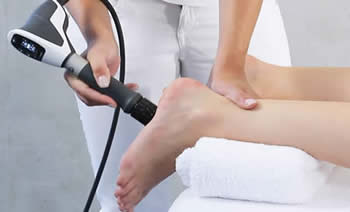
Heel pain is a frequent complaint among people who visit a podiatrist. It can have a variety of causes, such as plantar fasciitis, Achilles tendonitis, bursitis, Sever’s disease, and nerve pain. The location and type of pain that you are experiencing helps guide diagnosis.
Plantar fasciitis is an overuse injury of the ligament that runs along the bottom of your foot. It is caused by repetitive and excessive stress being placed on the heel, usually from participating in sports that involve a lot of running or jumping. The heel pain is usually described as a sharp, stabbing pain and is at its worst when you take your first few steps after a long period of rest, such as upon getting out of bed in the morning. Similarly, Achilles tendonitis is also an overuse injury, but of the Achilles tendon, which connects your calf muscles to your heel bone. The heel and back of the leg may be tender, painful, and swollen. Bursitis is an inflammation of the heel bursa, small fluid-filled sacs located inside the heel. It can cause redness and swelling in the fat pad of the heel. Sever’s disease is an overuse injury of the growth plate in the heel which most frequently affects children between the ages of 8 and 14. Nerve pain in the heel, while less common than pain from overuse, is often indicated by burning, stinging, or tingling sensations in the heel. These are usually caused by a compressed nerve.
Treatment for your heel pain will depend on your diagnosis. Frequently suggested treatments include activity and footwear modifications, orthotics, over-the-counter pain medications, and resting and icing the affected foot. Surgery can sometimes be necessary for more severe or chronic injuries. To find out what is causing your heel pain and how best to treat it, please consult with a podiatrist.
MLS Laser Therapy

When a physical condition or injury affects mobility or quality of life, there is one goal: A rapid return to every-day activities.
MLS Laser Therapy is an advanced laser technology that works to eliminate pain and reduce inflammation in the body in a safe, painless, and non-invasive way.
There are no known side-effects! Laser therapy is cleared by the FDA and is safe and effective.
Benefits of MLS Laser Therapy:
Rapidly reduces pain
Strong anti-inflammatory
Improves blood circulation
Quick Recovery of:
- sprains & strains
- the structure and function of an injured region
- swollen areas and surface injuries, such as wounds and ulcers
We are proud to be on the medical technological forefront by offering MLS Laser Therapy. We have invested in the very best technology as a key component of our continuing quest to offer you the finest in health care.
FAQs
Why choose MLS Laser Therapy?
MLS Laser Therapy does not require the use of drugs or surgery, there are no known side effects, and it is quick and convenient. According to studies performed by top academic institutions, such as Harvard University, laser therapy is equal to or more effective than other forms of therapy.
Will the treatment hurt?
No, laser therapy does not hurt. There is little or no sensation during treatment.
How long does a typical treatment session take?
The length of a typical treatment session is 10 to 15 minutes. However, it depends on the size of the area being treated. Treatments are usually received 2-3 times a week. Treatment plans are determined on an individual basis.
How many treatments does it take?
The number of treatments depends on the nature of the condition being treated. The typical course of treatment takes between 6 to 12 visits.
How long before results are felt?
You may feel improvement to your condition after 1 to 3 treatments. For some more chronic conditions, it may take up to 6 visits to feel the benefits of laser therapy. Not everyone responds to laser therapy in the same way.
Are the results long lasting?
MLS Laser Therapy is about healing. With MLS Laser Therapy, we are not masking or covering up a condition, but rather, treating the root of your pain and inflammation. Because of this, many patients have seen long-term results.
Can it be used in conjunction with other forms of treatment?
Yes, MLS Laser Therapy is sometimes more effective when combined with other forms of therapy, including physical therapy, chiropractic, massage, soft tissue mobilization, electrotherapy, and following surgery.
Shockwave Therapy

Shockwave therapy, or Extracorporeal Pulse Activation Technology (EPAT), is an effective non-surgical treatment for managing pain caused by a variety of disorders. In podiatry, shockwave therapy can be used to manage painful conditions in the foot and ankle that negatively affect mobility and quality of life.
Shockwave therapy works by generating pulse waves to produce kinetic energy. The kinetic energy is then converted into sound energy before being transmitted into the affected tissue to treat the pain at its source.
Shockwave therapy delivers successful non-surgical treatment to patients seeking convenience, less downtime, and less risk. A session of treatment typically lasts less than 10 minutes and allows patients to quickly return to regular activities.
Benefits:
- Non-invasive
- No anesthesia required
- No risk of infection
- No scarring
- No downtime
- Faster, easier healing

